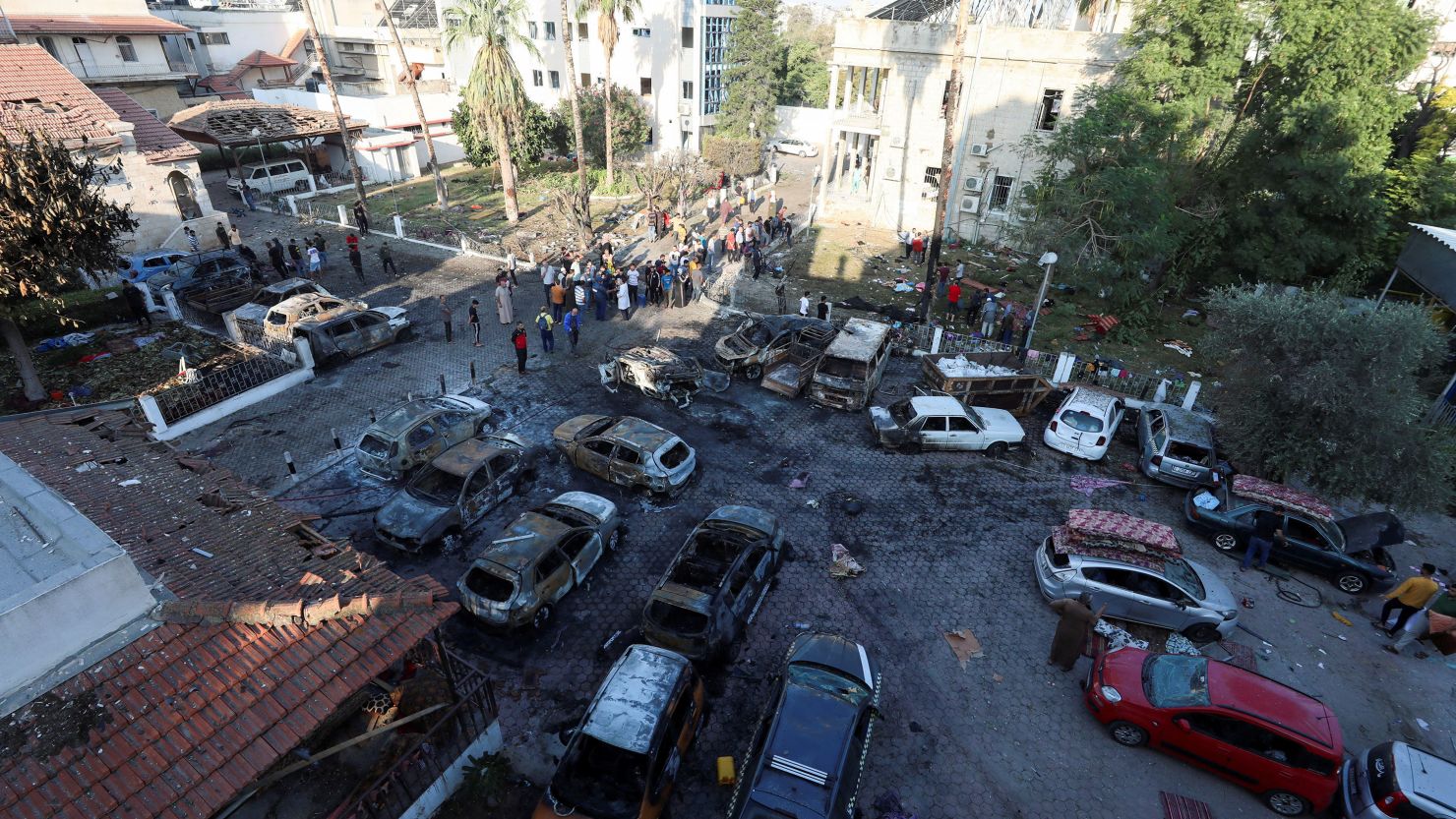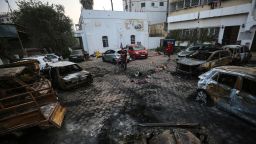A video cited by Israel and the United States as part of their assessments of the deadly Al-Ahli Baptist Hospital blast in Gaza on October 17 does not appear to be directly related to the explosion, according to a CNN analysis of several videos that builds on previous reporting.
CNN revisited the footage broadcast live by Al Jazeera on the night of the explosion to better understand what has been considered a key piece of evidence. While the new analysis adds to the evolving picture of what happened, it does not alter CNN’s earlier findings that the blast was likely caused by a malfunctioning rocket, not an Israeli airstrike.
After analyzing additional videos filmed from multiple angles, CNN was able to determine that the projectile captured in the Al Jazeera broadcast was likely fired from inside Israel, not from Gaza, as was previously concluded, and unlikely to have any connection to the explosion at Al-Ahli, miles away.
Open-source researchers @ArchieIrving2 and @OAlexanderDK on X, formerly known as Twitter, were the first to triangulate the footage and geolocate the likely launch site to Israel. The New York Times and The Washington Post also reached the same conclusion in recent reports.
In the immediate aftermath of the blast, CNN initially reviewed dozens of videos posted on social media, aired on live broadcasts and filmed by a freelance journalist working for CNN in Gaza, as well as satellite imagery, to piece together what happened at the hospital complex in as much detail as possible.
The open-source imagery showed a huge explosion and destruction from the fire at the hospital complex, which experts said was consistent with a failed rocket crashing to the ground with unspent fuel.
Weapons and explosive experts with decades of experience assessing bomb damage, who reviewed the visual evidence, told CNN they believe this to be the most likely scenario – although they caution the absence of munition remnants or shrapnel from the scene made it difficult to be sure. All agreed that the available images of evidence of the damage at the site was not consistent with an Israeli airstrike.
Still, no visual evidence has surfaced showing a rocket hitting the hospital, and CNN cannot exclude other possibilities. Without the ability to access the scene and gather evidence from the ground, no conclusion can be definitive.
The Israel Defense Forces (IDF) told CNN in a statement that the Al Jazeera video in question was never claimed as “definite proof” of its findings, which it said, “are supported by other resources and intelligence.”
In an interview with CNN on October 18, Lt. Col. Peter Lerner, a spokesman for the IDF, held up a piece of paper with a screenshot of the Al Jazeera footage printed on it, claiming it showed “the rocket that fell into the hospital.”
A spokesperson for the Office of the Director of National Intelligence, which produced the US government’s assessment of the hospital blast, declined to comment on CNN’s analysis of the video, or whether they stood by their own assessment.
“The U.S. Intelligence Community judges that Israel was not responsible for an explosion at the Al Ahli Hospital in the Gaza Strip,” the spokesperson said in a statement. “Instead, we assess that the explosion was caused by a failed rocket launched by Palestinian militants. Our assessment is based on multiple sources of information, including intelligence reporting and our evaluation of observed damage to the site.”
Three additional videos
To reassess the Al Jazeera footage, CNN reviewed three additional videos – one filmed by a cameraman on a rooftop in Gaza City, a livestream filmed from Bat Yam, a suburb of Tel Aviv, and a third filmed by CNN affiliate Israeli television station Channel 12 from the Israeli town of Netivot.
By geolocating the camera positions and establishing the field of view as seen in the videos, CNN was able to determine the rocket was likely fired near the Israeli town of Nahal Oz. CNN also determined that the projectile seemed to explode in the sky near the border with Gaza, miles away from Al-Ahli Hospital, making it unlikely to have caused the blast.
CNN could not independently verify the type of projectile seen in the video, but satellite imagery shows that the area estimated to be the launch location is within proximity of an Israeli military site, known to have an Iron Dome defense system. CNN could not independently assess whether what is visible in the video is in fact an Iron Dome interceptor missile. Israel says that it does not fire interceptors into Gaza.
Markus Schiller, a Germany-based missile expert who has worked on analysis for NATO and the European Union, told CNN that the projectile pictured in the Al Jazeera footage “matched the profile” of a Tamir interceptor missile launched by Israel’s Iron Dome, based on its rapid change in course, followed by the mid-air explosion seconds later.
“Tamir interceptors are only launched if the fully automated integrated air and missile defense system calculates a direct threat to certain areas, as to avoid intercepting missiles that hit fields, or sparsely inhabited areas,” said Schiller. “It is well possible that only a single interceptor was launched to intercept one of the missiles that went off course.”
The IDF did not respond to CNN’s request for comment about whether the Iron Dome was used to intercept a rocket fired from Gaza on the evening of October 17. Jonathan Conricus, an IDF spokesman, told The Washington Post that Israel did not make any interceptions around that time.
One of the videos CNN used to triangulate the Al Jazeera footage – a live shot of the Gaza Strip filmed from Bat Yam – captured a barrage of rocket fire illuminating the night sky over Gaza just before 7 p.m. The video appears to show the volley emanating from a location southwest of Al-Ahli Hospital, outside of Gaza City.
Schiller said that he estimated a Qassam rocket, which are used by Palestinian militants, would have taken about 25 to 40 seconds to reach the distance from the launch site to the hospital, depending on variables like launch angle, acceleration and burn time. He added that the most likely cause of the explosion was a rocket launched towards Israel “that fell short and hit the hospital’s parking lot” just a few seconds after what he described as the “intercept” seen in the Al Jazeera footage.
The location of the rocket barrage seemed to be consistent with a map released by the IDF on October 18 that it said showed rockets were launched from a site several kilometers away from the Al-Ahli hospital, from a southwesterly direction, with a trajectory towards the hospital. CNN cannot independently confirm whether a rocket fired from southwestern Gaza was responsible for the blast.
Israel said that a “misfired” rocket by militant group Palestinian Islamic Jihad caused the blast, a claim that US President Joe Biden said was backed up by US intelligence. A spokesperson for the National Security Council later said that analysis of overhead imagery, intercepts and open-source information suggested that Israel is “not responsible.”
Palestinian officials and several Arab leaders accused Israel of hitting the hospital amid its ongoing airstrikes in Gaza. Palestinian Islamic Jihad (or PIJ) – a rival group to Hamas – has denied responsibility.
Until an independent investigation is allowed on the ground and evidence is collected from the site, the prospect of determining who was behind the blast is remote.




